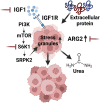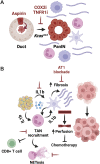Decoding the obesity-cancer connection: lessons from preclinical models of pancreatic adenocarcinoma
- PMID: 37648285
- PMCID: PMC10474221
- DOI: 10.26508/lsa.202302228
Decoding the obesity-cancer connection: lessons from preclinical models of pancreatic adenocarcinoma
Abstract
Obesity is a metabolic state of energy excess and a risk factor for over a dozen cancer types. Because of the rising worldwide prevalence of obesity, decoding the mechanisms by which obesity promotes tumor initiation and early progression is a societal imperative and could broadly impact human health. Here, we review results from preclinical models that link obesity to cancer, using pancreatic adenocarcinoma as a paradigmatic example. We discuss how obesity drives cancer development by reprogramming the pretumor or tumor cell and its micro- and macro-environments. Specifically, we describe evidence for (1) altered cellular metabolism, (2) hormone dysregulation, (3) inflammation, and (4) microbial dysbiosis in obesity-driven pancreatic tumorigenesis, denoting variables that confound interpretation of these studies, and highlight remaining gaps in knowledge. Recent advances in preclinical modeling and emerging unbiased analytic approaches will aid in further unraveling the complex link between obesity and cancer, informing novel strategies for prevention, interception, and therapy in pancreatic adenocarcinoma and other obesity-associated cancers.
© 2023 Ruiz et al.
Conflict of interest statement
MD Muzumdar received research support from an AACR grant funded in part by Genentech, Inc.
Figures





References
-
- Altea-Manzano P, Doglioni G, Liu Y, Cuadros AM, Nolan E, Fernández-García J, Wu Q, Planque M, Laue KJ, Cidre-Aranaz F, et al. (2023) A palmitate-rich metastatic niche enables metastasis growth via p65 acetylation resulting in pro-metastatic nf-κb signaling. Nat Cancer 4: 344–364. 10.1038/s43018-023-00513-2 - DOI - PMC - PubMed
Publication types
MeSH terms
Grants and funding
LinkOut - more resources
Full Text Sources
Medical
